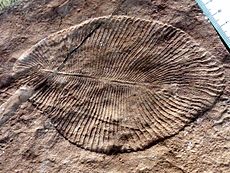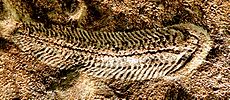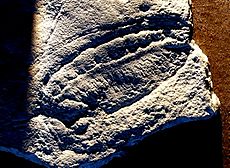Ediacaran biota facts for kids
The Ediacaran biota are the fauna of the Ediacaran period. This geological period was from 635–542 million years ago, but the fossil biota was only from 575–542 million years ago. This was after a series of ice ages and just before the Cambrian period. The biota consists of soft-bodied multicellular organisms, probably animals, which left trace fossils in rocks of Ediacaran age.
The biota is quite unusual, and there is no sign of it in the preceding Marinoan glaciation. The biota appears to suffer a fairly severe extinction event at the boundary with the Cambrian. Some of the biota may have survived into the early Cambrian.
Assemblages
Ediacaran-type fossils are recognised globally in 25 localities, and a variety of depositional conditions, and are commonly grouped into three main types, named after typical localities. Each assemblage occupies its own habitat, and after a burst of diversification changes little for the rest of its existence.
- The Avalon-type assemblage is defined at Mistaken Point Ecological Reserve in Newfoundland, Canada, the oldest locality with a large quantity of Ediacaran fossils.
- Ediacara-type assemblage: the Ediacara-type assemblage consists of fossils preserved in areas near the mouths of rivers (prodeltaic). They are found in interbedded sandy and silty layers formed below the normal base of wave-related water motion, in waters shallow enough to be affected by wave motion during storms. Most fossils are preserved as imprints in microbial mats, but a few are preserved within sandy units.
- Nama-type assemblage: the Nama assemblage is best represented in Namibia. Three-dimensional preservation is most common, with organisms preserved in sandy beds containing internal bedding.
Significance of assemblages
In the White Sea region of Russia, all three assemblage types have been found close together. This, and the faunas' overlap in time, makes it unlikely that they represent evolutionary stages. Since they are found on all continents except Antarctica, geographical boundaries do not appear to be a factor. The same fossils are found at all palæolatitudes.
Probably the three assemblages mark organisms adapted to survival in different environments. An analysis of one of the White Sea fossil beds, where the layers cycle from continental seabed to inter-tidal to estuarine and back again a few times, found that a specific set of Ediacaran organisms was associated with each environment.
It is no surprise that not all environments are exploited. Of 92 possible modes of life — combinations of feeding style, tiering and motility — no more than a dozen are occupied by the end of the Ediacaran. Just four are represented in the Avalon assemblage. The lack of large-scale predation and vertical burrowing are perhaps the most significant factors limiting the ecological diversity; the emergence of these during the early Cambrian allowed the number of lifestyles occupied to rise to 30.
Related pages
Images for kids
-
Modern cyanobacterial-algal mat, salty lake on the White Sea seaside
-
Global ice sheets may have delayed or prevented the establishment of multicellular life.
See also
 In Spanish: Biota del periodo Ediacárico para niños
In Spanish: Biota del periodo Ediacárico para niños















